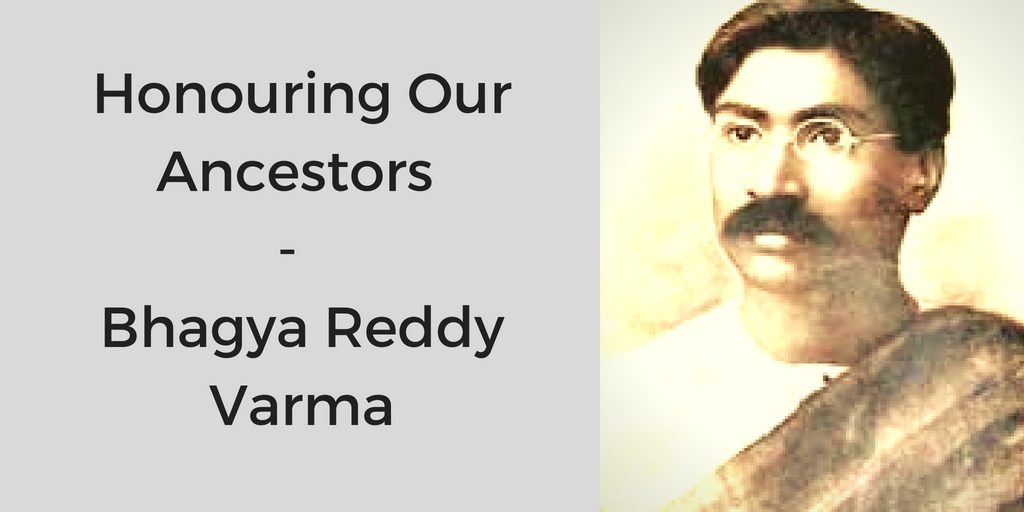
Honouring Our Ancestors – Bhagya Reddy Varma
Bhagya Reddy Varma was among the first few leaders from the untouchable castes to raise the voice of dissent as well to serve the society by any means possible and available. Before Babasaheb Ambedkar arrived on the scene, our people have been making their efforts in whatever way they could and whatever understanding they had due to their limited educational training and social handicaps. The scene began to change drastically with the advent of Babasaheb Ambedkar, who took a lot of efforts to gain the training and develop his intellectual capacities in order to emancipate his people.
His own life was the outcome of the struggle that had gone before him. Had it not been for the great struggle of Jotiba Phule, we would not have seen the great intellectuals like Dada Keluskar of the non-Brahmin movement, who groomed young Bhim to lead the non-Brahmin movement. Had it not been for the great Siddhanaga and the valour of Mahar soldiers at Bhima Koregaon, the emergence of the non-Brahmin movement would have been impossible. The revolutionary spirit finds ways to expand in all the possible ways and hence the most important factor in the social movement is the timeless revolutionary spirit: what I mean thereby is the commitment to do whatever one can to transform the society.
The revolutionary spirit is embodied by the individuals, and as it is true with all the individuals, their power to respond to the situation is determined by the situation itself: the political, social, economic, technological, and legal situation. Therefore, the present generation has no way to judge or evaluate the revolutionary ancestors from the circumstances and awakening of today, and that our revolutionary ancestors from all over India deserve respect and our admiration for whatever they did for our society. The intention and commitment are important, as the actions are contextual and consequential.
The great men like Bhagya Reddy Varma in the Telugu-speaking region, Baba Mangoo Ram in the north, along with Iyothee Thass in Tamil Nadu wanted to claim that the untouchables were not Hindus and they also wanted to challenge and destroy the identities imposed on them by the upper castes. Most of these upper caste given identities were political ploys to subsume the untouchables politically in the identity politics of Hinduism. The Brahminical media tried to blame the Bahujan politics, but long before that the Brahminical tactic was revolving around identity and imposition of their identities on others with force and persuasive propaganda. The way the Bhangis were made into Valmikis and others were forced to become Hindu are some of the graphics examples.
The great leaders mentioned above revolted and declared the emancipatory identities that go well beyond the pale of Brahminical identity politics. They claimed that they are Adi-, the prefix that claims that they were “before” any identity. Who were they “before”?
They were Adi-Andhra, Adi-Hindu, and Adi-Dravida. The claim that they were before the linguistic, regional, and communal identities were forged by the upper castes in the modern times is an important step to leave the clutches of Brahminism. Adi is a revolutionary term which smashes the identity politics of the Brahmins and establishes the process that makes the untouchables search for their roots in what is not Hindu, Andhra, or Dravid, to cite some identities in which the untouchables were locked into. If the untouchables were Adi, then they were the Adivasis (the misnomer used for the tribals only), their cultures, their religion, their philosophy was to be before the Brahminism. Judging by the history, it seems that the most of the oppressed classes were Adi and this is what Gustav Oppert, the German Indologist, proved based on the linguistic analysis that the untouchables were the original inhabitants.
As the consciousness among the untouchables caste who were confined to villages and to a particular caste identity is expanding, the untouchable movement is now too big a reality to be handled by and controlled by the regional forces, caste identities, and linguistic confines. A Telugu-speaking Madiga in the village of Telangana is not alone, she has her brothers in the towns of Punjab and sisters in the villages of Uttar Pradesh, and maybe a cousin in the USA. With this rise in the consciousness among the untouchables of the past, it creates new possibilities for the movement and with new possibilities new enlightened identities can be claimed in the future. This is what is required at the moment in our struggle: learning from the past, understanding the present, and forging ahead in the future!
Author – Mangesh Dahiwale, Human Rights Activist



+ There are no comments
Add yours